The Urea Value Chain in Mexico: From Natural Gas Supply to Imports of Basic Food Staples
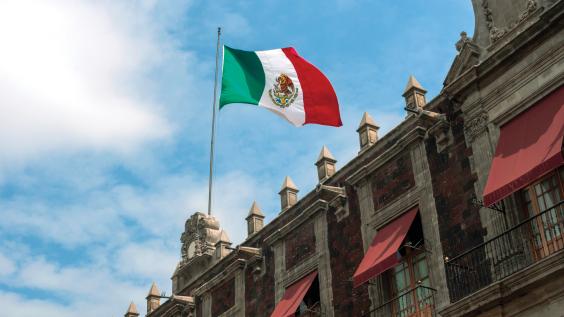
Table of Contents
Author(s)
Adrian Duhalt
Former Nonresident Scholar in Mexico Energy StudiesShare this Publication
- Download PDF
- Print This Publication
- Cite This Publication Copy Citation
Duhalt, Adrian. 2018. The Urea Value Chain in Mexico: From Natural Gas Supply to Imports of Basic Food Staples. Issue brief no. 09.28.18. Rice University’s Baker Institute for Public Policy, Houston, Texas.
The collapse of urea production in the late 1990s is one of the lingering effects of Mexico’s former energy policy framework and a pressing issue that policymakers have been unable to address. Recent developments suggest that such productive activity may be closer to reclaiming part of its previous strength. The scarcity of locally sourced urea (i.e., nitrogen fertilizers) that farmers in Mexico have coped with over the last two decades—and the resulting increase in urea imports—might finally be tackled due to a strategy led by Petróleos Mexicanos (PEMEX). In January 2014, PEMEX purchased urea facilities1 (now operating as Pro-Agroindustria) in Coatzacoalcos, Veracruz, that had been inactive since 1999. Now, after years of revamping the facilities, production is reported to have resumed.2 With two plants ostensibly able to yield up to 0.99 million metric tons (MMT) of urea annually, PEMEX’s objective is to gradually supply a share of the 1.89 MMT Mexico imported in 2017.
The revival of urea production is consistent with the message of Mexico’s new President-elect Andrés Manuel López Obrador (AMLO), who during his campaign called for strengthening the agricultural sector, principally the production of basic staples such as corn, beans, rice, and wheat.3
And though it remains to be seen if urea production at Pro-Agroindustria can compete in a domestic market currently flooded with imports4—and without being subsidized by other divisions of PEMEX such as Exploration and Production—the restart of Pro-Agroindustria could have numerous broad impacts that are worth discussing in light of Mexico’s current political and economic context.
First, domestic urea production may have considerable impact on import substitution and related activities, such as 1) the supply of natural gas to southeastern Mexico (including the southern tip of Veracruz) and 2) the production of ammonia, a key feedstock in urea production. Thus, urea production is at the heart of a value chain that illustrates how Mexico’s energy reforms in 2013 and 2014 can encourage the development of energy-related industries.
Second, the issue of urea production fits well with the focus of the new López Obrador administration. Importantly, the supply of locally produced urea,5 if sold at competitive prices to Mexico farmers, aligns with recurrent arguments set out by AMLO during his campaign.6 The move to foster urea production can contribute to increasing agricultural productivity in Mexico’s most vulnerable regions—that is, southern states to which urea produced at Pro-Agroindustria can be easily distributed due to their geographical proximity. As such, urea production (as part of a broader policy framework) may help address regional imbalances between southern and northern Mexico and strengthen Mexico’s food sovereignty, two issues AMLO emphasized in his presidential campaign.7
That being said, if AMLO seeks to deliver on his agricultural promises and overhaul urea production, higher standards of efficiency must be established at Pro-Agroindustria than what PEMEX has accomplished in its downstream facilities in the past.
The Role of PEMEX and CENAGAS
PEMEX launched urea production at Pro-Agroindustria by putting one plant back in operation in May 2018; a second plant is projected to be operational later in 2018. With a combined overall capacity to produce up to 0.99 MMT of urea, the focus on restarting operations at Pro-Agroindustria centers on the impact it may eventually have on reducing Mexico’s reliance on imports and on upstream activities such as natural gas supply and ammonia production in southern Veracruz.
The shutdown of urea production in the 1990s left a gap in the domestic market that was soon filled by foreign suppliers. From 1993 to 2000, the year after production ceased, imports of urea grew by 5.6 times, from 0.22 MMT to 1.24 MMT, with the sharpest increase registered in the second half of the decade. Since the turn of the century, urea imports8 have continued to climb, reaching 1.89 MMT in 2017, a 52.4 percent increase since 2000 (Figure 1).9 Thus, at a projected 100 percent production capacity, Pro-Agroindustria alone could replace 52 percent of the urea Mexico imported in 2017. That depends on whether PEMEX can overhaul urea production, given that upstream activities confront their own challenges for the time being, and if the company can improve the operating efficiency of its urea production facilities.
Figure 1 — Mexico’s Imports of Basic Staples, Nitrogen Fertilizers, and Urea, and Domestic Ammonia Production (in Million Metric Tons)
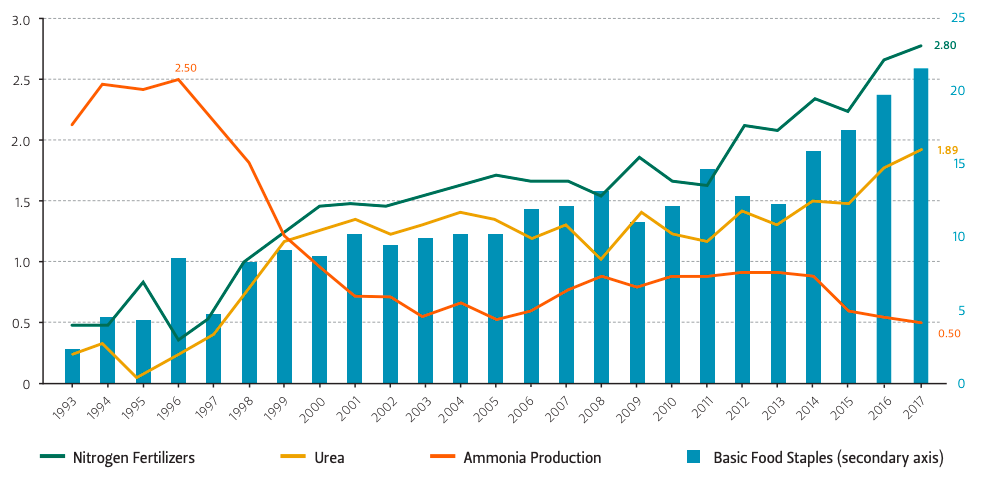
Also, the production of ammonia, which the nearby Cosoleacaque petrochemical complex10 is expected to supply, is contingent upon four PEMEX-owned plants that persistently experience technical difficulties. Local buyers claim that the supply of ammonia is frequently interrupted as production is brought to a halt due to a lack of adequate and timely maintenance of production equipment. This in part explains why ammonia production in Mexico has tumbled (Figure 1).
But technical difficulties are just one factor impacting the trajectory of ammonia production at Cosoleacaque. It has been widely reported that southern Veracruz contends with a limited supply of natural gas, which has effectively distressed operations at ammonia plants (and other PEMEX petrochemical plants in the region). Both the fall in natural gas production in Mexico and infrastructure bottlenecks help explain why productivity levels at PEMEX petrochemical facilities in the area have plummeted in recent years. For example, PEMEX reports that the monthly output at Cosoleacaque from January to July 2018 averaged 19,000 metric tons, a 57 percent plunge vis-à-vis the volume recorded in the same period in 2017.11 All in all, the government appears to be aware of the critical need to upgrade ammonia plants and restore the flow of natural gas to the southern region of Veracruz—and to southeastern Mexico in general—if the urea value chain is to be shored up.
Mexico’s Energy Secretariat (SENER) has sanctioned the development of projects that will help balance the supply of natural gas to southern Veracruz. For the National Center for Natural Gas Control (CENAGAS), the state-owned technical operator of Mexico’s largest pipeline grid, the ministry proposes upgrading the Cempoala compressor station in central Veracruz to facilitate the supply of natural gas from northern sources (i.e., imports via the South Texas—Tuxpan pipeline) to southeastern states. In addition, a rented floating storage regasification unit (FSRU) off the coast of Coatzacoalcos, where the Pro-Agroindustria urea plants are situated, is expected to source LNG from the U.S. to meet demand by PEMEX’s petrochemical plants in the region as well as other users such as power plants and industrial consumers in central Mexico.12
Importantly, urea production at Pro-Agroindustria may have a significant impact on the Cosoleacaque petrochemical complex, which highlights the importance of reestablishing the supply of natural gas to ammonia plants. PEMEX contends that each urea plant has the capacity to yield 1,500 metric tons daily; at full capacity, this would require 885 metric tons of ammonia, or 1,770 metric tons per day if both urea plants are operating.13 In annual figures, the petrochemical complex would need to produce—continuously—1.37 MMT of ammonia, or 174 percent more than the volume it produced in 2017 (Figure 1). And while capacity utilization will ultimately be less than 100 percent due to annual and unplanned maintenance, the numbers above illustrate the magnitude of the impact urea production could have on ammonia production.
The Ammonia-Urea Correlation
The collapse of the urea industry in the late 1990s is arguably the result of a policy that linked the price of domestic natural gas to prices along the southern coast of the United States, which were relatively high at that point in time. This caused a price spike that made the production of ammonia at Cosoleacaque and other PEMEX facilities—and therefore that of urea—unfeasible. As a result, Mexican production could not compete with international supply.14
In short, this policy greatly contributed to the pronounced fall in ammonia output in the second half of the 1990s. PEMEX’s production stood at 2.5 MMT in 1996 but plummeted to 0.92 MMT in 2000. This downward trajectory has continued until the present. With the limited supply of ammonia domestically, and the resulting high prices, urea imports soared rapidly from 9,374 metric tons in 1995 to 1.24 MMT by the end of the decade and to 1.89 MMT as of 2017. These numbers indicate that, in Mexico’s case, there seems to be a strong association between the drop in ammonia production and the rise in urea imports, which is hinted at in Figure 1.
Likewise, Figure 2 illustrates the virtually perfect linear correlation between the levels of ammonia production (Y) and urea imports (X) from 1990 to 2017. Both variables register a solid negative correlation of -0.96149, indicating that a drop in ammonia production is almost proportionally mirrored by a rise in urea imports.15
Figure 2 — Linear Correlation Between Ammonia Production and Urea (in Million Metric Tons)
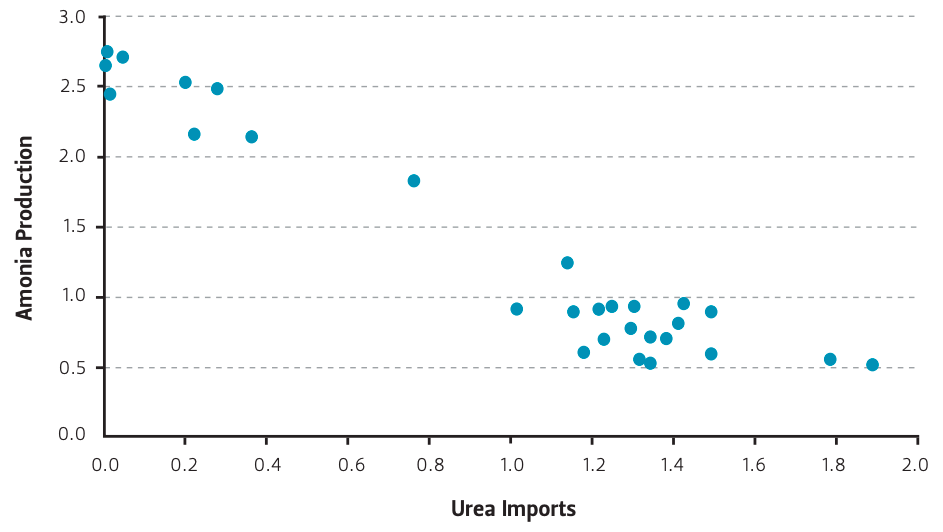
Imports of Basic Food Staples
The production of basic food staples (corn, wheat, rice, and beans)16 is a crucial component of the economic architecture of Mexico’s rural areas, where 20.5 percent of the country’s population resides.17 Approximately 58.2 percent of this population lives in poverty.18 Mexico’s strong dependency on imports of food staples garnered attention from López Obrador, who in the months leading up to the July 1 election pledged to strengthen the country’s food sovereignty. To paraphrase, he proposed to improve living conditions in rural areas by “making Mexico’s agroindustry great again”—although the campaign proposal failed to underline the potential influence urea production at PEMEX-owned plants may have on accomplishing that goal.
Mexico’s inability to produce urea domestically is one of several factors that explain the recent state of its agriculture industry, at least with respect to basic food staples, whose production failed to increase in tandem with apparent consumption. This has left a gap in Mexico’s market that has been filled by additional imports (Figure 3). From 1999 to 2005, production of basic food staples stayed flat, growing marginally from 22.12 MMT to 23.46 MMT (an increase of 6.05 percent), whereas food imports expanded from 8.92 MMT to 10.26 MMT (a 15 percent increase). In subsequent years, despite food production increasing to 32.71 MMT in 2017 (a rise of 39.4 percent vis-à-vis 2005), the gap continued to broaden as imports stood at 21.57 MMT (a jump of 110 percent compared to 2005).
Figure 3 — Mexico’s Production of Basic Food Staples, Overall Imports, and Apparent Consumption (in Million Metric Tons)
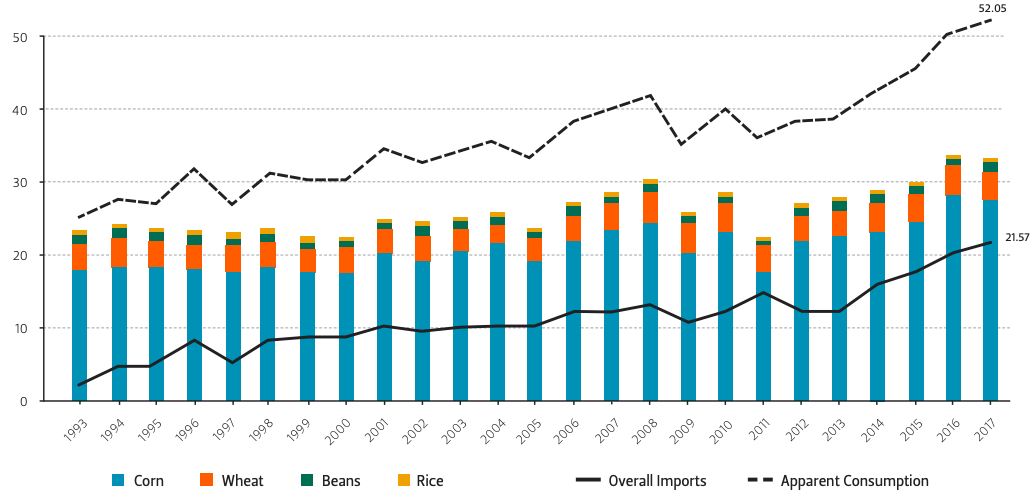
But do imports really jeopardize a country’s food security? A report published by the Superior Audit Office of the House of Representatives (ASF), the specialized technical body that oversees the use of federal resources across government agencies, cites findings from the Food and Agricultural Organization of the United Nations (FAO) suggesting that the share of imports should not be higher than 25 percent of domestic consumption. The last year that Mexico registered a figure lower than that was 1997, when imports accounted for 18 percent of consumption.19
Mexico’s ability to meet its demand for basic staples through domestic production started to worsen as the North American Free Trade Agreement (NAFTA) went into effect (Figure 4). In 1993, imports accounted for just 9 percent of consumption; since then, imports surged to 41 percent of apparent consumption in 2017, the highest level since the passage of NAFTA. Of the country’s four basic staple foods, Mexico is most dependent on imports for rice (82 percent), followed by wheat (62 percent), corn (37 percent), and beans (12 percent), as noted in Figure 4.20
Figure 4 — Imports of Basic Food Staples As a Percent of Apparent Consumption
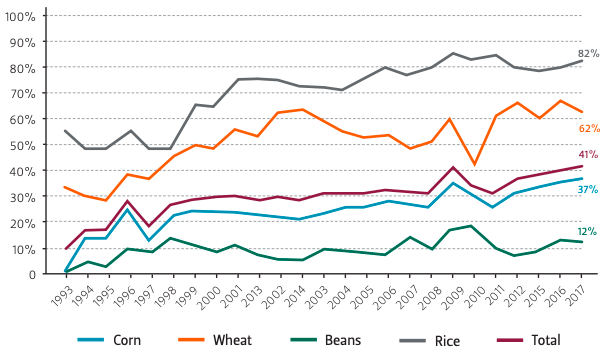
Out of all the basic staple foods, corn deserves special consideration since it is the foremost driver behind Mexico’s overall imports in terms of metric tons (71.11 percent in 2017). Here, the rise of corn imports is not associated with a fall in domestic production, which in fact expanded by 53 percent between 1993 and 2017, from 18.13 MMT to 27.76 MMT. Rather, the gap is explained by the fact that such an increase in production proved to be insufficient to match the expansion of domestic demand over that period. Mexico’s apparent consumption grew from 18.29 MMT in 1993 to 41.44 MMT in 2017, which equals a jump of 126.6 percent (Figure 5).
Figure 5 — Mexico’s Production and Imports of Corn
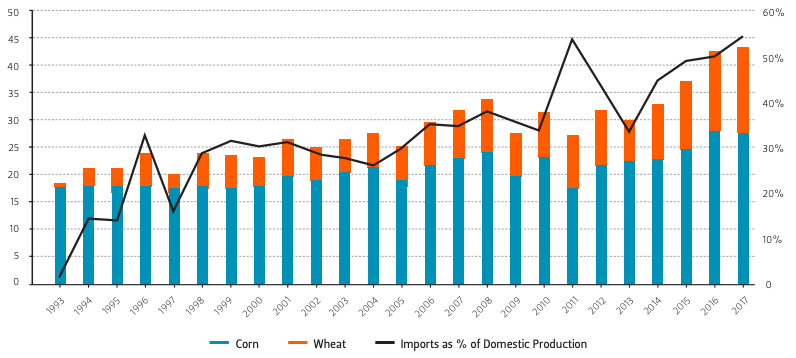
Import dependency has become acute, in relative terms. As depicted in Figure 5, the share of corn imports in relation to domestic production rose steeply over the last two and a half decades, from 1.2 percent in 1993—when Mexico bought just 0.21 MMT of corn—to 55.3 percent in 2017—when imports reached 15.34 MMT. And these are figures that many—including the Peña-Nieto administration21—believed could be lessened through a broader policy framework that includes the development of the urea value chain. Given his campaign promises, Mexico’s president-elect should be similarly inclined.
Policy Implications
The breakdown of the urea value chain in the 1990s was in part the result of natural gas pricing. Since Mexico now has greater access to the inexpensive natural gas supply from shale formations in the United States, restoring part of the urea value chain is a discussion worth having.
Putting the urea plants in Coatzacoalcos, Veracruz, back into operation could impact multiple downstream activities, including ammonia production at the Cosoleacaque petrochemical complex and infrastructure investment to reestablish the natural gas supply in the region. This demonstrates how Mexico’s aggressive strategy around natural gas supply can also strengthen the country’s industrial apparatus, in addition to being a major force behind the development of the power sector. This elucidates the wide effects that the deepening of the instrumentation of Mexico’s energy reform can have over a broader economic spectrum.
Moreover, if PEMEX manages to increase the supply of ammonia, it can have a positive impact on firms that produce other nitrogen fertilizers in Mexico. Likewise, the infrastructure projects CENAGAS is planning (i.e., the Cempoala compressor station and the floating regasification unit) may also foster economic activity as they deliver additional volumes of natural gas to southern Veracruz and beyond. That could persuade PEMEX to revamp production at the three other petrochemical complexes it operates in the region, and also prompt industrial users to invest in southeastern states
As for the incoming López Obrador administration, AMLO will need to examine two issues that are deeply embedded in the energy policy: 1) the future of energy reforms that began under the previous administration, which AMLO criticized at the beginning of his campaign before somewhat toning down his rhetoric; and 2) the complex nature of Mexico’s relationship with the U.S., which can guarantee the secure delivery of inexpensive shale gas but is also Mexico’s food supplier.
Domestic production of urea could become one of the key elements to delivering food sovereignty—one of the new president-elect’s major campaign promises. The eventual supply of urea to farmers in rural Mexico would be well received by AMLO’s political base. This could in turn provide the president-elect political cover to continue with the current energy reform. In fact, AMLO has an opportunity to expand and deepen the reform to help other areas of Mexico’s economy, including agriculture, petrochemicals, downstream projects, and potentially other economic activities (manufacturing) that could benefit from a greater supply of natural gas and a more efficient energy sector.
Endnotes
1. Petróleos Mexicanos (PEMEX), “PEMEX will reactivate production of fertilizers in Mexico,” press release No. 5, January 16, 2014, http://bit.ly/2zwlmxV.
2. The company was previously known as Agronitrogenados.
3. “What is AMLO’s strategy for the agricultural sector?” El Financiero, July 11, 2018, http://bit.ly/2xQgBgz.
4. In 2017, the value of Mexico’s urea imports was $477.66 million, of which $136.18 million was obtained from Russia and $128.33 million from China, according to data from the UN Comtrade Database.
5. According to the Standard International Trade Classification (SITC) used by the UN Comtrade Database, nitrogen fertilizers are classified as follows: urea (310210), ammonium sulphate (310221), ammonium sulphate-nitrate mix (310229), ammonium nitrate (310230), ammonium nitrate limestone (310240), sodium nitrate (310250), calcium-ammonium nitrate mix (310260), calcium cyanamide (310270), urea-ammonium nitrate mix (310280), and nitrogenous fertilizer mixes (310290). The numbers in brackets are the SITC codes given to each commodity. This issue brief focuses on urea because it accounts for a large percentage of imports and domestic consumption in Mexico.
6. To find out more about the candidates’ proposals, see: José Antonio Meade, “Propuestas por un campo exitoso y competitivo,” accessed June 15, 2018, http://bit.ly/2Q5gN34; Gustavo Pineda, “¿Cuál es la propuesta de Anaya para apoyar el campo?” Cultura Colectiva, accessed May 28, 2018, http://bit.ly/2zwIsoo; Andrés Manuel López Obrador, “Programa del Movimiento Regeneración Nacional,” accessed June 16, 2018, http://bit.ly/2InBzIR.
7. The notion of food sovereignty, as used by Andres Manuel López Obrador during his campaign, relates to Mexico’s ability to produce a large share of its own food staples and depend less on imports.
8. In dollar terms, Mexico’s urea imports totaled $20.3 million in 1993, $147.3 million in 2000, and $477.65 million in 2017.
9. From 2000 to 2017, urea represented 74 percent of the overall volume of Mexico’s nitrogen fertilizer imports.
10. The Cosoleacaque petrochemical complex is situated about 28 km from the Pro-Agroindustria urea plants.
11. Petróleos Mexicanos (PEMEX), “Petroleum Statistics April 2018: Petrochemical Production,” http://bit.ly/2xGiOMh.
12. Secretariat of Energy (SENER), Third Annual Review. 5-year Plan for the Expansion of the National Integrated Transportation and Storage System of Natural Gas, 2015-2019, http://bit.ly/2Q8JBrr.
13. Each ton of urea requires 590 kg of ammonia, according to PEMEX. See http://bit.ly/2xDHd5q.
14. Adrian Duhalt, “Industrial Cluster Governance in a Developing Country Context: Evidence from the Petrochemical Sector in the Mexican State of Veracruz” (unpublished doctoral thesis, University of Sussex, Brighton, 2011), http://bit.ly/2N4Eh6y.
15. A similar exercise was conducted for ammonia output and nitrogen fertilizers (excluding urea), resulting in a much weaker correlation of -0.50052.
16. Secretariat of Agriculture, Livestock, Rural Development, Fisheries and Food (SAGARPA), “¿Que son los granos básicos?” May 23, 2017, http://bit.ly/2xFWSBc.
17. World Bank, Rural Population as % of Overall Population, Mexico 1960-2016, http://bit.ly/2xGpH0p.
18. National Council for the Evaluation of the Social Development Policy (CONEVAL), “CONEVAL informs the evolution of poverty in Mexico, 2010-2016,” press release No. 09, August 30, 2017, http://bit.ly/2R02D4D.
19. Comisión de Vigilancia de la Auditoría Superior de la Federación (CVASF), “Análisis del Informe del Resultado de la Fiscalización Superior de la Cuenta Pública 2012,” May 2014.
20. When imports are compared with domestic production, the breakdown of import dependency in 2017 is as follows: rice (437 percent), wheat (120 percent), corn (55.3 percent), and beans (12.7 percent).
21. Secretariat of Agriculture, Livestock, Rural Development, Fisheries and Food (SAGARPA), “President Enrique Peña Nieto announces that there will be reform of Mexican agriculture,” November 6, 2013, http://bit.ly/2N35V3R.
This material may be quoted or reproduced without prior permission, provided appropriate credit is given to the author and Rice University’s Baker Institute for Public Policy. The views expressed herein are those of the individual author(s), and do not necessarily represent the views of Rice University’s Baker Institute for Public Policy.


